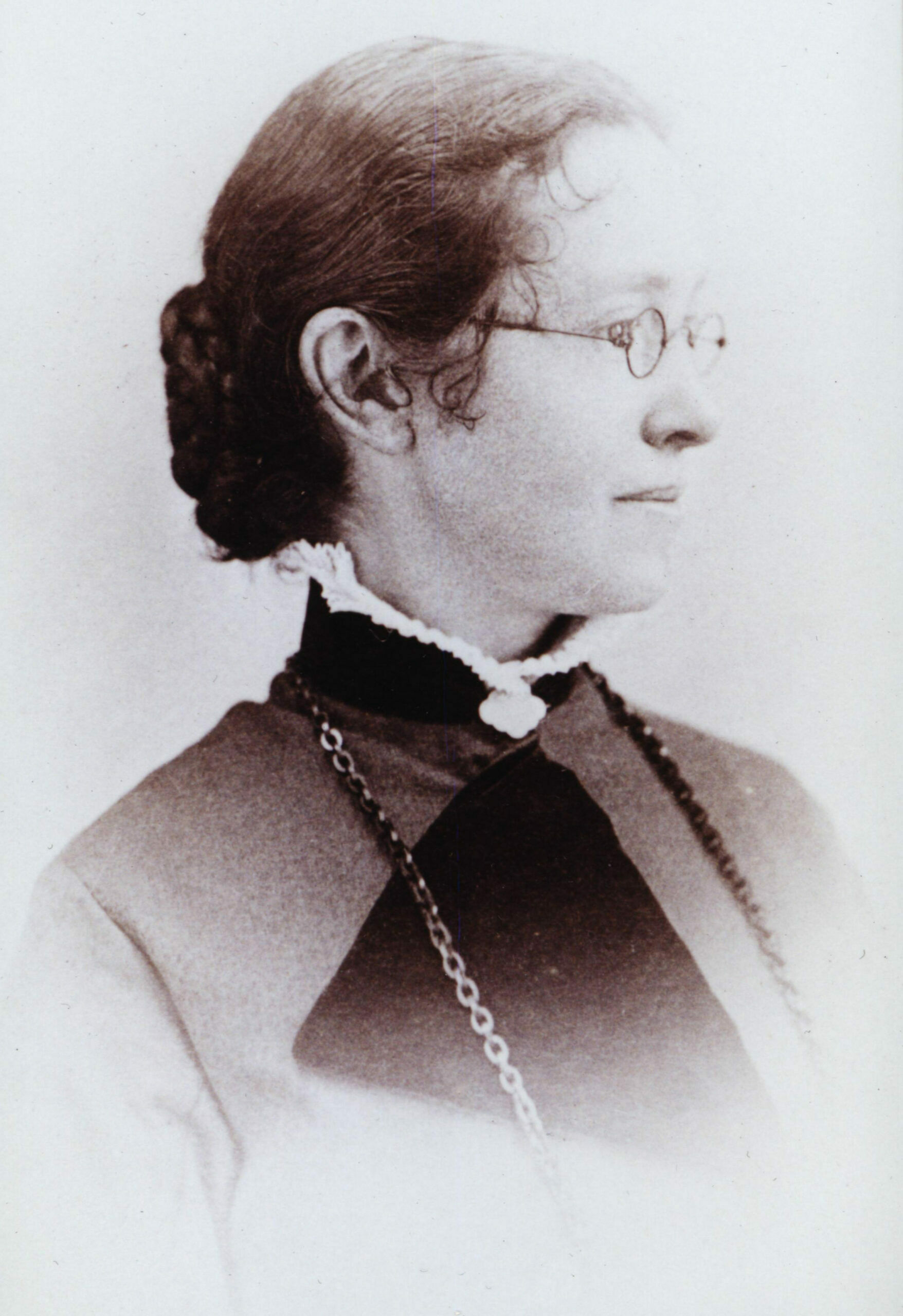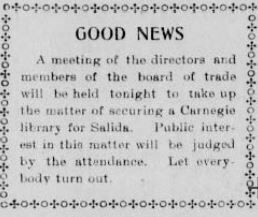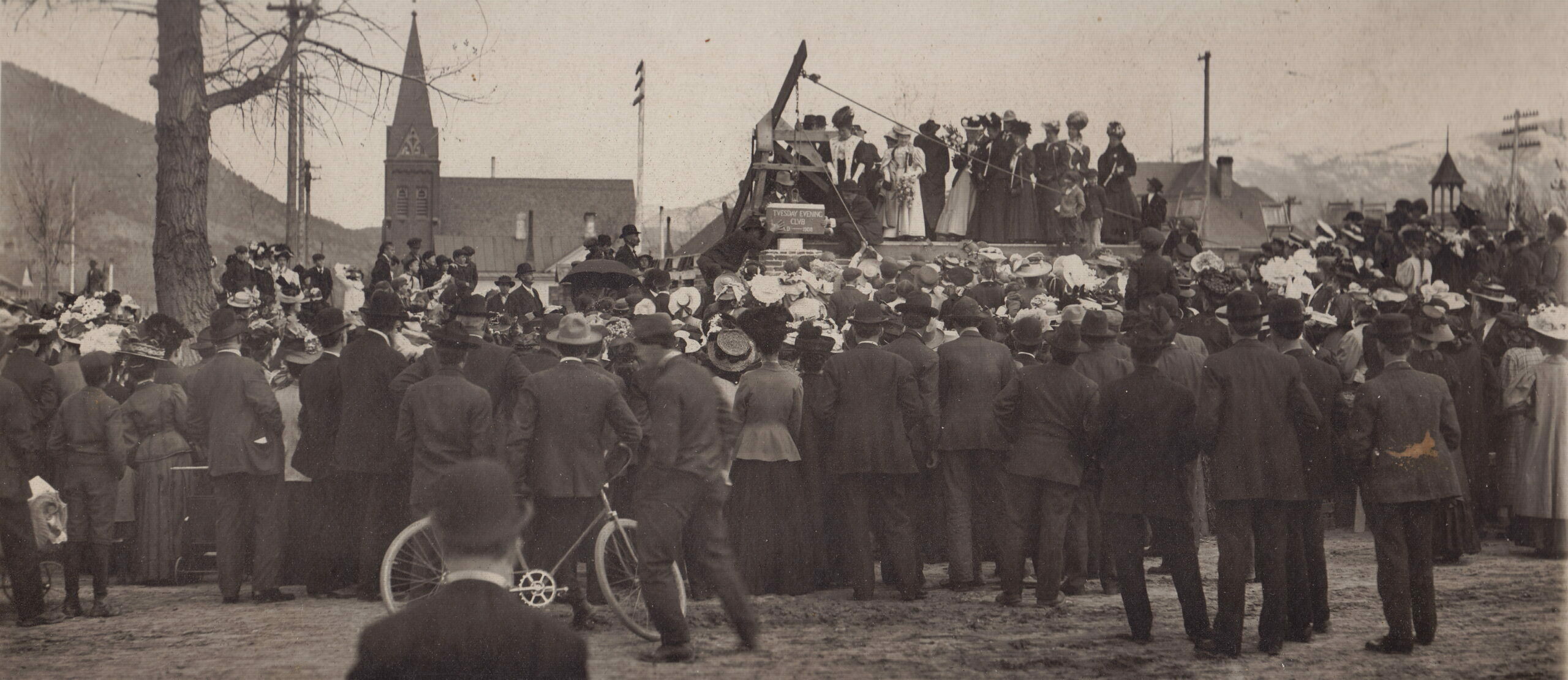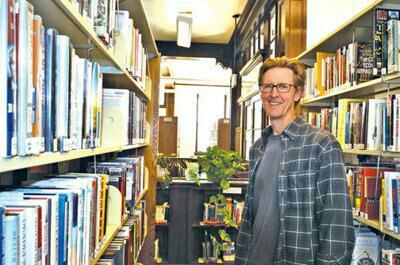
Ruth Hinshaw Spray
History of the Salida Library
In 1894, only 14 years after Salida was incorporated, a group of eleven townswomen formed the Tuesday Evening Club. One of the cultural objectives of this organization was to found a city library. During the first year, the few books purchased from club dues were kept on donated shelves at Central school. In 1896, the growing collection was moved to a small room on West second street, near the old opera house. In 1898, the library was relocated first to a small one-story brick building at the corner of “F” and third streets, and later to a large second story room in City Hall. To supplement the early book purchasing budget, the Tuesday Evening Club sponsored numerous public benefits. The members also took turns serving as librarian and custodian, except when the collection was at Central School.
The campaign for procuring a site and raising funds to build a public library started in 1905. That year, Mrs. Ruth Spray wrote, “For years, some of us had looked longingly on the vacant place by Alpine Park, corner of “E” and Fourth Streets, as the only site that was perfect for our library. Whenever we would speak of that location, we were met on all sides with ‘But you cannot get hold of those lots. People have tried in vain to reach the owner of them.’” The Tuesday Evening Club determined to find the owners of the vacant land and purchase the lots for the public library. The location was ideal: across from beautiful Alpine Park, between the two principal schools, and near the downtown business area.
Only a few months later, they located owners S.G. Stein in Muscatine, Iowa and A.M. Barnhart in Chicago, Illinois. In late 1905 correspondence began and, by November 10, 1906, they had obtained the lots. Mrs. Mary Ridgway was the first president of the Tuesday Evening Club, and she and her husband, Carl (A.C.), donated the generous sum of $1,200 to pay for the lots.
While the land campaign progressed, the club began to correspond with millionaire Andrew Carnegie of New York City. He had decided as a young boy that if he ever became wealthy, he would use his wealth to help establish free public libraries. The club was able to convince Mr. Carnegie that the community of Salida would faithfully support a public library. On December 23, 1905, he said he would provide $9,000 toward the construction of the library building if the club had a site for the building. The entire Carnegie donation was received by November, 1908. The community was to provide $6,000.

Salida Mail articles, 1905-07
reporting the inception of the Salida Public Library
Many Salida citizens were interested in the efforts of the Tuesday Evening Club to build a public library. One of the staunchest library supporters was Colonel William Penn Harbottle, a Civil War veteran and highly respected citizen. Upon his death in early 1906, it was learned that he had willed his personal library and his home at 546 “G” Street to the Salida Library Association, an organization within the Tuesday Evening Club. His will stipulated that it be known as the Juliana Reference Library, for his mother, and that it be a non-circulating library wherever it might be housed. The Juliana Reference room remains an important part of the library today and the Harbottle Estate continues to provide part of the funding for this part of the collection.
The eagerly awaited ground breaking ceremony took place in October, 1907. The handsome Salida-granite cornerstone was laid in May, 1908, and the deed to the library transferred to the city. In February, 1909, the library was dedicated and opened for service. Total construction costs were $15,000.

‘It Is Worthwhile’
from a talk given by Mrs. Lillian Mosgrove at the Eight Annual Convention of the South Central District held in Salida, Colorado, May 17, 1932 — the eleven founding members of the Tuesday Evening Club were: Mary Ridgway, Georgia Morrison, Lillian Mosgrove, Sarah Disman, Innes Frame, Martha Deen Jones, Amelia Evans, Ora Rech, Hattie Cornwell, Katherine D. Rudolph, and Mary Imlay Sisson.
To give a glimpse in ten minutes of the work of thirty-eight years will require rapid sketching.
We organized in 1894 with eleven members. The purpose of our organization ‘to widen the outlook of women, aid in the betterment of our community and to that end establish and maintain a public library and reading rooms’ made a wide appeal and our membership increased rapidly.
From the start we were ambitious. Adopting the motto ‘Operae pretium est’ we tried to do worthwhile things. Our first study was a university extension course in general history. Then followed in turn the study of the literature and music of the different countries. We wrote papers, gave book reviews, discussed the trend of modern literature and studied parliamentary law. Everyone was interested and everyone worked.
After a time we divided into departments; literature, music and art, and home and current events. General meetings were held once a month.
We were only two or three years old when we started the library. Just a few books at first but once started our enthusiasm knew no bounds and many entertainments were given to raise funds. We also booked lyceum courses and chautauquas, the first given in our community, the club assuming the local management and ticket selling.
I have forgotten how many books we had accumulated when we rented a room (on the corner of F & 3rd) and opened our library. Then began our work as librarians, For twelve years we served in turn three afternoons a week. Also we served as janitor, each librarian had to make a fire, take care of the ashes and clean. It was often a struggle to pay the rent, so it was a great relief and joy to us when the city recognized our efforts by giving us quarters in the City Hall over the Fire Department. It seemed very luxurious to come to a warm room, and there being plenty of space for our general meetings, the music and art department purchased a piano for the club.
During these years we were greatly cheered and encouraged by Mr. Harbottle’s bequest for a reference library and Mr. Carnegie’s promise to help and build.
Mr. Carnegie gave us $9,000. Our first president, Mary C. Ridgway (gave) $1,200 for the lots, and the balance was raised by entertainments and subscriptions.
The library building was completed in 1908 and we moved in our books and at a brilliant reception turned our loved library – our child – over to the city.
While the library, to which we still contribute, has always been our first love, we have always aided in civic improvements and kept up our interest in the state federation, contributing to the scholarship funds and creating a small one of our own to aid our home girls in getting a start.
Working in our own corner we have not sought recognition abroad, although twice our club has taken honors in the state poetry contests.
We led in the celebration of the Washington Bi-Centennial and each summer help a flower show.
So while our work is not as strenuous as in former years we still try to do things that are worthwhile.
L.D.M.
The Tuesday Evening Club planned meeting rooms into the lower level of the library. The club leased this area until the 1970’s, using it as a place to host various money-making events for the benefit of the library or subleasing it for the same purpose. In the 1970’s, the library board determined that the library needed the space and the insurance company no longer allowed subleasing, so the Tuesday Evening Club lease was discontinued. The library gradually become more crowded over the following 20 years and storage consumed an ever greater portion of the meeting rooms. This trend continued until the library addition was completed in 1998 and the meeting rooms returned to their original purpose.
In November, 1974, the voters approved the formation of the Southern Chaffee County Regional Library District with a 1.5 mill levy increase. This resulted in a broader tax base beginning in 1976 and thus provided more operational funds. The Salida Public Library name was changed to “Salida Regional Library” to represent the larger area now served.
Voters approved additional funding for the library in two subsequent elections. In the early 1980s, the mill levy was increased to 2.5 mills. In 1995, the levy was increased again to 3.5 mills, plus a bond was approved for construction of the addition to the Carnegie building.
In 2012, both the 1995 addition and the Carnegie building were remodeled to increase space for shelving. A larger area was designated for public computer use and work space for staff.

E Street Elevation of the Carnegie Library in Salida, Colorado
Salida Library is Best in U.S.
Salida Mail, April 28, 1922
Salida Library Has Unique History
Salida Daily Mail-Record, July 2, 1948
History and Growth of the Salida Library
by F.W. Gloyd
Starting in April 2000, Salida Library Director Jeff Donlan wrote a weekly column for the local paper, the Mountain Mail. Jeff retired from the library in 2015, but here’s a link to access those columns:

